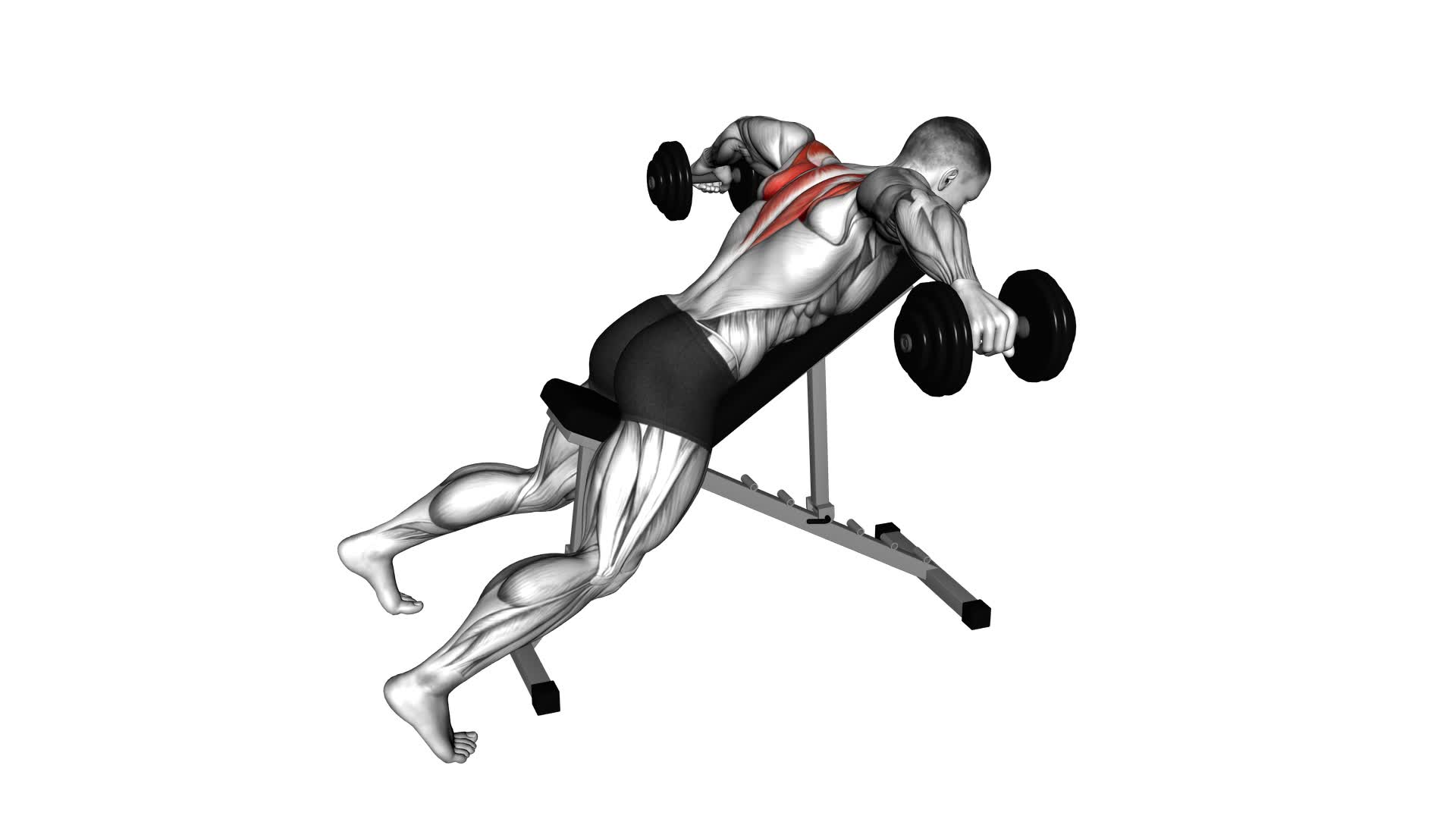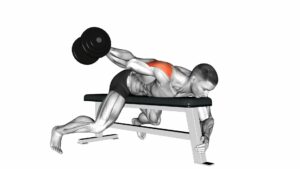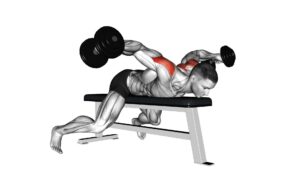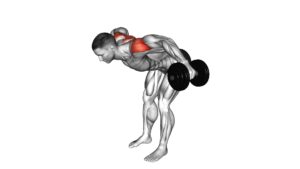Dumbbell Incline Rear Lateral Raise – Video Exercise Guide & Tips

Are you looking to target your rear delts and upper back? Then the dumbbell incline rear lateral raise is the exercise for you. By using this exercise, you can strengthen and sculpt those hard-to-reach muscles.
Watch This Exercise Video
In this video exercise guide, we'll show you the proper form and technique for maximum effectiveness. Don't miss out on our expert tips and common mistakes to avoid.
Get ready to take your workout to the next level with the dumbbell incline rear lateral raise.
Key Takeaways
- Dumbbell incline rear lateral raise increases shoulder strength and stability.
- It targets posterior deltoids, upper traps, and rhomboids.
- The exercise improves posture and shoulder stability.
- It strengthens hard-to-reach muscles and sculpts the upper back and shoulders.
Benefits of Dumbbell Incline Rear Lateral Raise
You can experience increased shoulder strength and stability with the benefits of the dumbbell incline rear lateral raise. This exercise primarily targets the posterior deltoids, which are the muscles located at the back of your shoulders. Additionally, it also works the upper traps and rhomboids, which contribute to better posture and shoulder stability.
To incorporate the dumbbell incline rear lateral raise into your workout routine, start by sitting on an incline bench with your chest resting against the pad. Hold a dumbbell in each hand with your palms facing each other. Keep your arms slightly bent and your elbows in line with your shoulders. Engage your core and lift the dumbbells to the sides, squeezing your shoulder blades together as you do so. Make sure to maintain control and avoid using momentum to swing the weights up.
To maximize the benefits of this exercise, focus on maintaining proper form and executing each repetition with control. Start with lighter weights and gradually increase the resistance as you become more comfortable and confident. Aim for 2-3 sets of 10-12 repetitions, and remember to rest for 1-2 minutes between sets to allow for adequate recovery.
Equipment Needed for Dumbbell Incline Rear Lateral Raise
To perform the dumbbell incline rear lateral raise, you'll need a set of dumbbells.
Using dumbbells for this exercise offers several benefits, such as increased range of motion and the ability to target specific muscles.
To ensure proper form and technique, it's essential to choose the appropriate weight and maintain a controlled movement throughout the exercise.
Required Equipment for Exercise
To perform the Dumbbell Incline Rear Lateral Raise, you'll need a set of dumbbells and an incline bench. The incline bench is essential for this exercise as it allows you to target the rear deltoids more effectively. By using an incline bench, you increase the range of motion and engage the upper back muscles to a greater degree.
This exercise is a variation of the traditional lateral raise and offers several benefits. Incline exercises, in general, provide a different angle of resistance, helping to target specific muscle groups more intensely. Incorporating different variations of dumbbell exercises, like the Dumbbell Incline Rear Lateral Raise, in your workout routine can help improve shoulder strength, stability, and overall upper body development.
Benefits of Using Dumbbells
Using dumbbells for the Dumbbell Incline Rear Lateral Raise offers a multitude of benefits, enhancing the effectiveness of this exercise and targeting specific muscle groups more intensely.
One of the advantages of using dumbbells is that they allow for a greater range of motion compared to other equipment. This increased range of motion engages more muscle fibers, leading to improved muscle development and strength.
Additionally, dumbbells require more stabilization from the muscles, which helps to improve overall balance and core strength.
Another benefit of using dumbbells is that they allow for unilateral training, meaning you can work each side of your body independently. This helps to correct any strength imbalances and ensures that both sides of your body receive equal attention and development.
Proper Form and Technique
To perform the Dumbbell Incline Rear Lateral Raise with proper form and technique, you'll need the following equipment:
- Dumbbells: Choose a weight that challenges you but allows you to maintain proper form throughout the exercise.
- Incline Bench: Set the bench to a comfortable angle, usually between 30 to 45 degrees.
- Exercise Mat: Place the mat on the bench to provide cushioning and stability.
- Water Bottle: Stay hydrated during your workout to prevent muscle cramps and fatigue.
- Towel: Keep a towel nearby to wipe away sweat and maintain a comfortable grip on the dumbbells.
By using the proper equipment, you can minimize the risk of injury and maximize the results of your Dumbbell Incline Rear Lateral Raise.
Now, let's dive into the proper form and technique for this exercise.
Proper Form and Technique for Dumbbell Incline Rear Lateral Raise
Ensure that you're properly positioned on the incline bench before beginning the dumbbell incline rear lateral raise.
This exercise targets the rear deltoids, helping to strengthen and sculpt your upper back and shoulders.
To maximize results and avoid common mistakes, follow these proper form and technique guidelines.
First, adjust the incline bench to a 45-degree angle. Lie face down with your chest and stomach pressed against the bench. Grab a dumbbell in each hand with an overhand grip and let your arms hang straight down. Keep a slight bend in your elbows throughout the exercise.
Next, engage your core and squeeze your shoulder blades together. This will help stabilize your upper body and ensure proper form. Slowly raise the dumbbells out to the sides, keeping your arms straight and maintaining control. Lift until your arms are parallel to the ground or slightly higher.
Avoid using momentum or swinging your body to lift the dumbbells. Focus on using your shoulder muscles to perform the movement. Pause briefly at the top of the motion, then lower the weights back down to the starting position in a controlled manner.
Common Mistakes to Avoid During Dumbbell Incline Rear Lateral Raise
When performing the dumbbell incline rear lateral raise, it's important to be aware of common mistakes to avoid. By avoiding these mistakes, you can prevent injuries and ensure that you're getting the most out of your workout. Here are some common misconceptions and mistakes to watch out for:
- Using too much weight: It's important to choose a weight that allows you to maintain proper form throughout the exercise. Using too much weight can lead to improper technique and potential injuries.
- Raising the dumbbells too high: Avoid lifting the dumbbells above shoulder level as this can put unnecessary strain on your shoulders and increase the risk of injury.
- Swinging the dumbbells: Keep the movement controlled and avoid swinging the dumbbells to prevent cheating and maintain proper form.
- Leaning forward or arching the back: Maintain a stable and upright position throughout the exercise to engage the targeted muscles effectively.
- Neglecting the mind-muscle connection: Focus on contracting and engaging the rear deltoids during the exercise to maximize their activation and effectiveness.
By being mindful of these common mistakes and misconceptions, you can perform the dumbbell incline rear lateral raise safely and effectively.
Now, let's move on to the next section to learn some tips to maximize your results with this exercise.
Tips to Maximize Results With Dumbbell Incline Rear Lateral Raise
To maximize your results with the dumbbell incline rear lateral raise, it's important to focus on proper form techniques.
Maintain a slight bend in your elbows, keep your back straight, and engage your core throughout the exercise. This will ensure that you're effectively targeting your rear deltoids and maximizing the benefits of this workout.
Additionally, choose a weight range that challenges you without sacrificing your form, typically starting with lighter weights and gradually increasing as you build strength.
Proper Form Techniques
Maximize your results with the dumbbell incline rear lateral raise by focusing on proper form techniques. To ensure you get the most out of this exercise, here are some key tips to follow:
- Maintain a slight bend in your elbows throughout the movement to engage your rear delts effectively.
- Keep your back flat against the bench to prevent any excessive arching and maintain stability.
- Avoid using momentum by controlling the weight and moving in a slow and controlled manner.
- Squeeze your shoulder blades together at the top of the movement to fully activate your rear delts.
- Use a weight that challenges you but still allows you to maintain proper form.
By following these proper form techniques, you can avoid common mistakes and maximize the results of your dumbbell incline rear lateral raise.
Targeting Rear Deltoids
To effectively target your rear deltoids with the dumbbell incline rear lateral raise, focus on maintaining proper form and engaging the muscles throughout the movement. The rear deltoids are an important muscle group located at the back of your shoulders, and targeting them can help improve the overall strength and appearance of your upper body.
This exercise specifically targets the rear deltoids by isolating them and putting them under tension. To maximize results, make sure to keep your back flat against the bench, and lift the dumbbells out to the sides while keeping a slight bend in your elbows.
Focus on squeezing your shoulder blades together at the top of the movement for an extra contraction. By incorporating this exercise into your shoulder workouts, you can effectively strengthen and tone your rear deltoids.
Now, let's move on to the recommended weight range for this exercise.
Recommended Weight Range
To maximize your results with the dumbbell incline rear lateral raise, it's important to use an appropriate weight range that challenges your rear deltoids without compromising your form or risking injury. Here are some tips to help you choose the recommended weight and maximize your results:
- Start with a weight that allows you to perform the exercise with proper form.
- Gradually increase the weight as your strength and technique improve.
- Aim for a weight that allows you to complete 8-12 reps with good form.
- If you can easily complete more than 12 reps, it's time to increase the weight.
- Listen to your body and adjust the weight accordingly to ensure you're challenging your muscles effectively.
Variations and Progressions of Dumbbell Incline Rear Lateral Raise
Try out different variations and progressions of the Dumbbell Incline Rear Lateral Raise to challenge your muscles and enhance your shoulder and back strength. Adding variations to your routine can help target different muscle fibers and prevent plateaus in your training.
One variation you can try is the Single-Arm Dumbbell Incline Rear Lateral Raise. Instead of using both arms simultaneously, this exercise isolates one side of your body, increasing the demand on your muscles. You can also experiment with different angles of incline to further challenge your muscles.
Another progression is to increase the weight of the dumbbells. As your strength improves, gradually increase the weight to continue challenging your muscles. However, it's important to maintain proper form and control throughout the movement to avoid injury.
You can also incorporate supersets or drop sets into your routine. Supersets involve pairing the Dumbbell Incline Rear Lateral Raise with another exercise targeting the same muscle group, such as the Dumbbell Shoulder Press. Drop sets, on the other hand, involve performing multiple sets with decreasing weights, pushing your muscles to fatigue.
Remember to listen to your body and progress at a pace that's comfortable for you. By incorporating variations and progressions into your Dumbbell Incline Rear Lateral Raise routine, you can continue to challenge your muscles and achieve optimal results.
Frequently Asked Questions
How Many Repetitions Should I Do for the Dumbbell Incline Rear Lateral Raise?
For the dumbbell incline rear lateral raise, the optimal repetition range is typically around 8 to 12 reps. This allows you to target and strengthen your rear delts effectively.
However, if you want to add more challenge and variation to your workout, you can try increasing the weight or incorporating drop sets.
Another option is to perform the exercise with a resistance band or on an incline bench to engage different muscles and increase the difficulty.
Can I Perform the Dumbbell Incline Rear Lateral Raise With a Barbell Instead of Dumbbells?
Yes, you can perform the dumbbell incline rear lateral raise with a barbell instead of dumbbells. This exercise targets your rear delts and upper back.
However, using a barbell may limit your range of motion and make it harder to isolate the target muscles.
If you don't have access to dumbbells, you can try alternative exercises like bent-over rows or face pulls to work the same muscle groups.
Is It Necessary to Use an Incline Bench for the Dumbbell Incline Rear Lateral Raise?
You don't need to use an incline bench for the dumbbell incline rear lateral raise. There are alternative exercises that target the rear delts without an incline bench.
Some variations include the bent-over lateral raise and the seated rear lateral raise. These exercises can be done with dumbbells or even a barbell if you prefer.
Experiment with different variations to find the one that works best for you.
Can I Substitute the Dumbbell Incline Rear Lateral Raise With a Different Exercise for Targeting the Rear Delts?
Yes, there are different exercises you can do to target your rear delts. However, before considering substitutes, it's important to understand the benefits of the dumbbell incline rear lateral raise.
This exercise specifically targets the rear delts, helping to strengthen and build muscle in that area. It also engages other muscles in your upper body, promoting overall upper body strength.
How Often Should I Incorporate the Dumbbell Incline Rear Lateral Raise Into My Workout Routine?
To properly perform the dumbbell incline rear lateral raise, follow these steps:
1) Set an incline bench at a 45-degree angle.
2) Hold a dumbbell in each hand with palms facing down.
3) Bend forward at the waist and let your arms hang straight down.
4) Raise your arms out to the sides until they're parallel to the ground.
Incorporating this exercise into your routine can help target and strengthen your rear delts, improving shoulder stability and posture.
Conclusion
In conclusion, the dumbbell incline rear lateral raise is an effective exercise for targeting the rear deltoids and upper back muscles. By using proper form and technique, avoiding common mistakes, and incorporating variations and progressions, you can maximize your results and develop strength and definition in these areas.
Remember to start with a weight that challenges you but allows for proper form, and gradually increase the weight as you progress.
Incorporate this exercise into your routine for a well-rounded upper body workout.

Author
Years ago, the spark of my life’s passion ignited in my mind the moment I stepped into the local gym for the first time. The inaugural bead of perspiration, the initial endeavor, the very first surge of endorphins, and a sense of pride that washed over me post-workout marked the beginning of my deep-seated interest in strength sports, fitness, and sports nutrition. This very curiosity blossomed rapidly into a profound fascination, propelling me to earn a Master’s degree in Physical Education from the Academy of Physical Education in Krakow, followed by a Sports Manager diploma from the Jagiellonian University. My journey of growth led me to gain more specialized qualifications, such as being a certified personal trainer with a focus on sports dietetics, a lifeguard, and an instructor for wellness and corrective gymnastics. Theoretical knowledge paired seamlessly with practical experience, reinforcing my belief that the transformation of individuals under my guidance was also a reflection of my personal growth. This belief holds true even today. Each day, I strive to push the boundaries and explore new realms. These realms gently elevate me to greater heights. The unique combination of passion for my field and the continuous quest for growth fuels my drive to break new ground.







